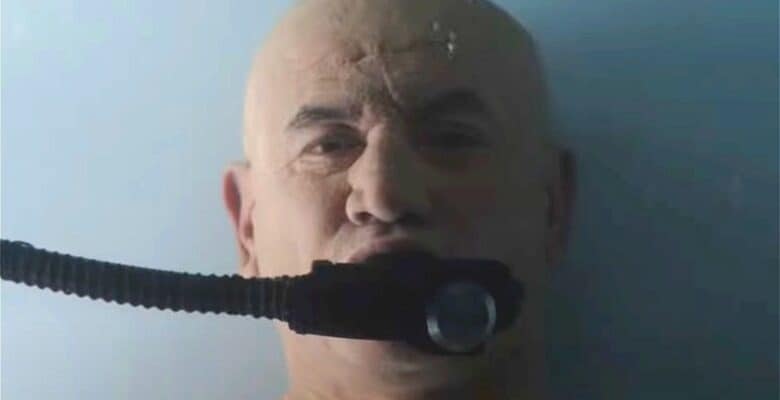
In one of the opening scenes of the Star Wars spinoff, The Book of Boba Fett, the bounty hunter lies immersed in a strange pod filled with gel. Dream-like flashbacks flutter in and out as the gelatinous liquid in the so-called “bacta tank” bathes Boba Fett, healing his wounds and easing his chronic pain.
Plot-wise, this sci-fi invention makes sense. Boba Fett is bound to have way more aching muscles than the ordinary office worker slouched over their desk. He’s suffered plenty of skin damage in the harsh desert of Tattooine. He also fell into the Sarlacc, suffering injuries from the creature’s stomach acid.
But is this regenerative medical technology real science, or simply real good sci-fi? Inverse speaks with Mohab Ibrahim, Medical Director of the University of Arizona’s Comprehensive Pain and Addiction Center, to answer all your questions about the bacta tank and discuss how the Disney+ show sheds light on a painful human condition impacting millions of people.
As it turns out, there are some real medications that bear a slight resemblance to gel in the bacta tank, although whether you should bathe in them is another question altogether.
“As far as I know, there is no therapy that immerses people in fluids or gel to control their pain,” Ibrahim tells Inverse.
Reel Science is an Inverse series that reveals the real (and fake) science behind your favorite movies and TV.
The real-life equivalent of Bacta Tank gel

The bacta tank contains a gelatinous fluid that heals Boba Fett’s wounds and eases his chronic pain. For the purposes of our discussion, we’re going to focus on the latter application.
As it turns out, there are plenty of gels that do work to alleviate inflammatory pain, and you don’t need to build a fancy tank to use them. Instead, you can head to your nearest pharmacy.
“There are topical medications that people can apply to their skin to control pain,” Ibrahim says.
Two of the most popular pain-reducing gels include Voltaren and lidocaine. If you’ve ever used an Icy Hot Lidocaine Patch after a painful workout, you’re not too far off from Boba Fett (minus the whole bounty hunter thing).
Each of these gels works differently, but their biochemical processes offer some insight into how the gel in the bacta tank might ease Boba Fett’s pain. Ibrahim explains the pain-easing mechanisms behind lidocaine.
“Lidocaine is a local anesthetic. Local anesthetics work by blocking the sodium channel” in nerves, Ibrahim says. The sodium channel is necessary for nerves to receive and send signals, thereby blocking sensory signals that cause pain.
“Think of a nerve as an electrical wire that transmits an electrical signal,” he explains. “The sodium channels allow for that signal to go from point A to point B.”
When it comes to the skin repairing aspect of the bacta tank, lidocaine wouldn’t work so well, but studies show that aloe vera — a plant used since ancient times for to heal wounds — may prove helpful.
Can you bathe in “bacta tank” gel?

To his knowledge, Ibrahim says there aren’t any gels or liquid designed to ease chronic pain by bathing in them. Instead, the bacta tank bears a greater resemblance to the kinds of synthetic wombs seen in The Matrix.
“That whole concept of people soaking themselves in some kind of container of fluid — I think that idea comes from a baby in a womb where the baby is covered by the amniotic fluid,” Ibrahim says.
He likens the bacta tank in The Book of Boba Fett to a type of regenerative medicine imagined more in science fiction than reality, though recent scientific developments could change that.
But, hypothetically speaking, could you safely bathe in lidocaine? Definitely not, Ibrahim says.
He explains that every medication has a “therapeutic window” for efficacy.
“If you give too little of any medication, you're most likely not going to get benefits. If you get too much, then you get into the toxic aspects of it,” Ibrahim says.
He adds, “When you apply all that lidocaine all over the body at once, you get into the toxic range.”
So, bathing in lidocaine would probably push the gel into the toxic range. When local anesthetics like lidocaine get into the toxic range, they can cause cardiac arrhythmias, seizures, neurological disorders, or even stop the heart from beating.
He adds that bathing in lidocaine also isn’t practical, and is too expensive, for many chronic patients who don’t have pain “head to toe” like Boba Fett.
Even if you can’t bathe in lidocaine — seriously, please don’t do this — Ibrahim says there are other pain relief methods that metaphorically bathe the patient, if not literally.
These types of immersive practices for chronic pain include sound therapy and aromatherapy. Ibrahim says researchers still aren’t sure how they work, but it’s possible they can impact the central nervous system by activating certain receptors in the nose, eyes, and ears.
Apart from bathing, are there other widespread pod-like treatments — like hyperbaric oxygen chambers — resembling the bacta tank for chronic pain? Not yet.
A 2018 Canadian report found “evidence to suggest that two months of hyperbaric oxygen therapy increases pain thresholds, physical functionality, and health-related quality of life” in female patients with fibromyalgia, but the researchers weren’t able to draw conclusions regarding its long-term effectiveness or its feasibility for “treatment of chronic musculoskeletal pain.”
How should Boba Fett be treated for chronic pain?

But just what exactly is chronic pain, and how is it different from short-term acute pain?
“The general definition — and this is an overall definition that may not apply to everyone — is when pain goes for more than three months,” Ibrahim says.
Ibrahim says chronic pain is a condition “which we do not fully understand.”
“Some people view it as not real or fake or someone who's just trying to find an excuse,” Ibrahim says, “But we see them in the pain clinic, and they do have real pain issues.”
He adds, “Just because we don't understand the pathophysiology doesn't mean that condition does not exist.”
So, how would Ibrahim treat Boba Fett if he were his patient? Instead of tossing him into a bacta tank, Ibrahim says he’d start by finding a diagnosis.
“Why is this individual is having pain all over the body?” Ibrahim asks. “Is it just multiple traumas over the years given his line of [work] or does he have neurological issues that causes pain?”
Next, he’d ask where Boba Fett is experiencing pain, i.e., in the muscles, bones, or joints. These questions could help determine if Boba Fett has genetic conditions or a viral infection causing chronic pain.
“Once we find the diagnosis, then we can start a plan for treatment,” Ibrahim says. Lidocaine infusions — placing an IV in the hand or arm to pump lidocaine — is an approved treatment, though doctors must monitor carefully in case there’s an overdose.
Putting aside the bacta tank, The Book of Boba Fett sheds light on a real-life medical problem impacting millions of people around the world. According to a 2016 study, anywhere from 11 to 40 percent of the US adult population suffers from chronic pain.
For such a prevalent issue, it doesn’t exactly get much screentime in Hollywood, making Boba Fett’s chronic pain an important onscreen depiction of a little-understood medical condition.
The Book of Boba Fett is streaming now on Disney+.







